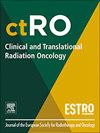Associations of dose to the urethra and long-term patient-reported outcomes after radiotherapy with EBRT and HDR brachytherapy boost for prostate cancer
IF 2.7
3区 医学
Q3 ONCOLOGY
引用次数: 0
Abstract
Purpose
Implications of radiation dose exposure to the urethra on urinary morbidity after prostate radiotherapy are poorly understood, especially by long-term patient-reported outcomes (PRO). Therefore, our primary objective was to investigate associations of urethral dose and long-term patient-reported urinary morbidity after external beam radiotherapy and high-dose rate brachytherapy boost for prostate cancer.
Materials and methods
We conducted a pre-registered (https://doi.org/10.17605/OSF.IO/A6DC3) cross-sectional study at a tertiary academic center including a consecutive sample of patients being at least two years after treatment. Primary outcome measurements included urinary domains of the EPIC-26 questionnaire. Their associations with predefined urethral dose levels were assessed by univariable analyses (Pearson’s correlation) and by predefined multivariable analyses (multiple regression). Sample size calculation was based on a predefined multivariable model. A p-value < 0.05 was considered statistically significant.
Results
Among 277 screened patients, 113 patients were alive, eligible, consented, and provided PRO. The median time passed since radiotherapy was 4 years. Per univariable analysis, a higher near maximum point dose of the urethra (DU0.1cc) was associated with worse urinary incontinence (r = -0.32; CI = −0.48 − -0.13; p < 0.001) and worse overall urinary function (r = -0.21; CI = −0.38 − -0.03; p = 0.02) of the respective EPIC-26 domains. Per predefined multivariable analysis, DU0.1cc and urinary incontinence remained significantly associated (B = −0.005; CI = −0.008 − -0.002; p = 0.003). These associations were only present, when very high DU0.1 cc above 137 Gy were kept in the analysis.
Conclusions
Very high urethral near point doses appear to be associated with worse long-term patient-reported urinary morbidity after radiotherapy for prostate cancer. Urethral dose should be considered in practice and future trials to potentially minimize long-term urinary morbidity.
Trial registration
The study protocol was pre-registered prior to patient accrual on the Open Science Framework (https://doi.org/10.17605/OSF.IO/A6DC3).
EBRT和HDR近距离放射治疗前列腺癌后,尿道剂量与患者报告的长期预后的关系
目的:尿道辐射剂量暴露对前列腺放射治疗后泌尿系统发病率的影响尚不清楚,特别是长期患者报告的结果(PRO)。因此,我们的主要目的是研究前列腺癌外束放疗和高剂量率近距离放疗后尿道剂量与患者报告的长期泌尿系统发病率的关系。材料和方法:我们在一个三级学术中心进行了一项预注册的横断面研究(https://doi.org/10.17605/OSF.IO/A6DC3),包括治疗后至少两年的患者的连续样本。主要结果测量包括EPIC-26问卷的尿域。通过单变量分析(Pearson相关)和多变量分析(多元回归)评估它们与预先设定的尿道剂量水平的关系。样本量的计算是基于一个预定义的多变量模型。p值结果:在277名筛选的患者中,113名患者存活,符合条件,同意并提供PRO。放疗后的中位时间为4年。单变量分析显示,较高的尿道近最大点剂量(DU0.1cc)与更严重的尿失禁相关(r = -0.32;Ci = -0.48 - -0.13;p < 0.1cc与尿失禁仍然显著相关(B = -0.005;Ci = -0.008 - -0.002;p = 0.003)。这些关联仅在分析中保持高于137 Gy的非常高的DU0.1 cc时才存在。结论:非常高的尿道近点剂量似乎与前列腺癌放疗后患者报告的较差的长期泌尿系统发病率有关。在实践和未来的试验中应考虑尿道剂量,以潜在地减少长期泌尿系统发病率。试验注册:研究方案在患者累积之前在开放科学框架(https://doi.org/10.17605/OSF.IO/A6DC3)上进行了预注册。
本文章由计算机程序翻译,如有差异,请以英文原文为准。
求助全文
约1分钟内获得全文
求助全文
来源期刊

Clinical and Translational Radiation Oncology
Medicine-Radiology, Nuclear Medicine and Imaging
CiteScore
5.30
自引率
3.20%
发文量
114
审稿时长
40 days
 求助内容:
求助内容: 应助结果提醒方式:
应助结果提醒方式:


